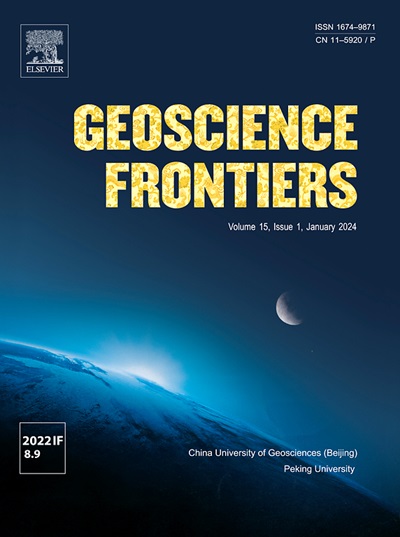湖相有机碳埋藏动力学调节阿普梯—阿普梯—阿普梯温室降温气候振荡
IF 8.9
1区 地球科学
Q1 GEOSCIENCES, MULTIDISCIPLINARY
引用次数: 0
摘要
研究陆地对典型温室期的响应对于理解过去和现在的气候-碳循环相互作用至关重要。白垩纪的气候转变被认为与碳循环有关,但湖泊系统在调节全球碳-气候反馈中的作用仍然很少受到限制。本文采用高分辨率的生物地球化学记录,综合了生物标志物、氮同位素和元素指标。研究发现,阿普梯早期的暖湿气候通过强化反硝化作用、甲烷循环和养分通量放大了湖泊有机碳埋藏,并可能通过N2O/CH4排放强化海洋缺氧事件1a (OAE1a)过热条件。随后的氮限制引发了蓝藻的优势,维持了适度风化下的碳固存,并有助于冷却阿普tian晚期的气候。早期Albian短暂的变暖阶段使氮池向NH4+方向转变,有利于真核藻类的繁殖,与全球OAE1b碳埋藏一致,是早期Albian晚期降温气候的原因之一。这些动态表明,古湖泊既是碳汇又是温室气体源,在白垩纪气候振荡中发挥了重要但以前被忽视的反馈作用。我们的发现强调了湖泊系统在过去碳循环扰动中的双重作用,为完善白垩纪碳循环与气候变化之间的关系提供了见解。本文章由计算机程序翻译,如有差异,请以英文原文为准。

Lacustrine organic carbon burial dynamics regulate Aptian-Albian greenhouse-cooling climate oscillations
Investigating terrestrial response to typical greenhouse periods is essential to understand past and present climate-carbon-cycle interactions. The Cretaceous climate transition is thought to be related to carbon cycles, yet the role of lacustrine systems in modulating global carbon-climate feedback remains poorly constrained. Here, we present a high-resolution biogeochemical record from an Aptian-Albian paleolake in northwestern China, integrating biomarkers, nitrogen isotopes, and elemental proxies. We reveal that warm-humid climates during the early Aptian amplified lacustrine organic carbon burial via intensified denitrification, methane cycling, and nutrient fluxes, potentially reinforcing oceanic anoxic event 1a (OAE1a) hyperthermal conditions through N2O/CH4 emissions. Subsequent nitrogen limitation triggered cyanobacterial dominance, sustaining carbon sequestration under moderate weathering and contributing to cooling the late Aptian climate. A transient early Albian warming phase shifted the nitrogen pool towards NH4+ and favored the bloom of eukaryotic algae, aligning with global OAE1b carbon burial and serving as one of the contributors to the late early Albian cooling climate. These dynamics demonstrate that paleolakes acted as both carbon sinks and greenhouse gas sources, exerting a critical but previously overlooked feedback on Cretaceous climate oscillations. Our findings highlight the dual role of lacustrine systems in past carbon cycle perturbations, offering insights for refining the relationships between the carbon cycle and climate changes in the Cretaceous.
求助全文
通过发布文献求助,成功后即可免费获取论文全文。
去求助
来源期刊

Geoscience frontiers
Earth and Planetary Sciences-General Earth and Planetary Sciences
CiteScore
17.80
自引率
3.40%
发文量
147
审稿时长
35 days
期刊介绍:
Geoscience Frontiers (GSF) is the Journal of China University of Geosciences (Beijing) and Peking University. It publishes peer-reviewed research articles and reviews in interdisciplinary fields of Earth and Planetary Sciences. GSF covers various research areas including petrology and geochemistry, lithospheric architecture and mantle dynamics, global tectonics, economic geology and fuel exploration, geophysics, stratigraphy and paleontology, environmental and engineering geology, astrogeology, and the nexus of resources-energy-emissions-climate under Sustainable Development Goals. The journal aims to bridge innovative, provocative, and challenging concepts and models in these fields, providing insights on correlations and evolution.
 求助内容:
求助内容: 应助结果提醒方式:
应助结果提醒方式:


